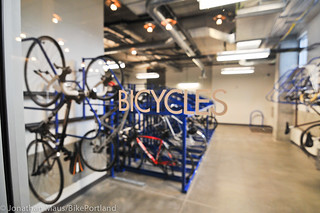Since we’ve taken some shots at Oregonian news coverage lately, it’s worth highlighting a moment of bike-friendly perceptiveness in their coverage.
Sunday’s cover story was the second in the paper’s occasional series about Portland’s changing Central Eastside, an “industrial sanctuary” that’s gradually been adding more office workers and, at the developing Burnside Bridgehead, several big apartment buildings.
The first installment, back in January, included some interesting perspective of what it feels like to run a truck-dependent business facing the Taylor Street neighborhood greenway. This weekend’s focused specifically on the food industry, and mentioned bicycles in the most casual way possible.
Stumptown, a relative newcomer, moved in 2012 to its headquarters in a 12,000-square-foot warehouse that previously housed a lumber yard and a computer-repair shop.
Within a few blocks are other coffee roasters, five distilleries, a half-dozen wine companies and at least two breweries. That might seem a disadvantage — customers don’t have to go out of their way to visit a competitor, and workers can decide to hang their bicycle elsewhere.
But Ricci said the creation of a fluid workforce is an advantage of being in close quarters with competitors and compatriots. There’s a large experienced workforce to draw upon. And the competition, he says, makes firms experiment and innovate.
Portland economist Joe Cortright called it a prime example of a thriving business cluster, a group of related businesses that shares workforce skills, suppliers and customers — and a neighborhood.
Advertisement
Did you blink and miss that? That was a bicycle commute being presented, with zero fanfare, as such a matter-of-fact activity that a bike can serve as a synecdoche for a job.
Best of all, the mini-metaphor is appropriate. Bike commuting is a huge part of the Central Eastside. Even back in 2006-2010, the most recent years for which workplace data is available, the Census-estimated bike-commute rate into the area was 6.3 percent, the highest for any employment-zoned part of the region. By now, it wouldn’t be a surprise if one in 10 Central Eastside workers arrived by bicycle as their primary mode. Many more workers than that surely bike in occasionally during the warm-weather months.
As one of the Central Eastside’s leading developers told us in 2013, bike access for workers is a major reason companies want to move to the area. Every time an institution like The Oregonian acknowledges that reality with a turn of phrase, bicycling becomes a little less exotic to the people reading it, and a little more like what it actually is: one of several standard options for moving around your city.


